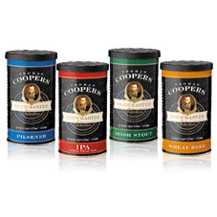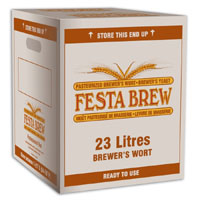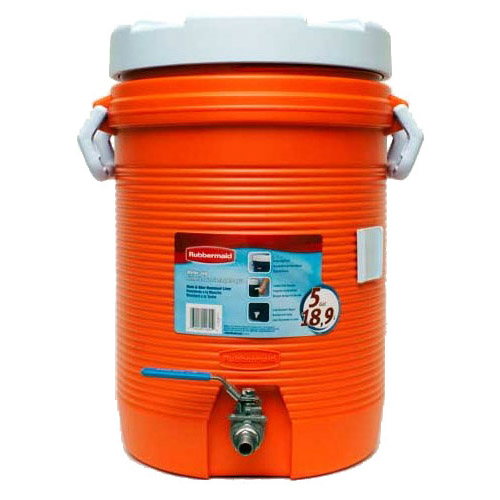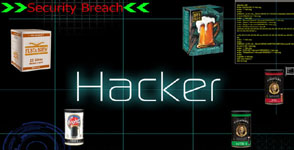Brewing Beer at Home
There are a variety of methods for brewing beer at home. The simplest are kits, that in some cases are as easy as pouring the wort (unfermented beer) into a fermenter and pitching yeast. Most folks start out with kits and quickly wish to “step up their game”. Outlined below are the most common methods of homebrewing in order of increasing complexity. If you’re into craft beer and DIY, the hobby of homebrewing will likely evolve to utilize some or all of these methods to produce more refined and higher quality beers. Don’t be afraid to dive in as none of these methods are out of the realm of the weekend warrior.
This article discusses the following brewing methods:
Kits
The simplest and most straightforward way to jump into the hobby of homebrewing is with a high quality beer kit. These take the recipe formulation out of the brewer’s hands and let him/her focus on fermentation. This approach lets the brewer select a beer style from a large pool of styles and promises to deliver a beer that is within that style guideline. The best way to relate beer kits (in my humble opinion) is to compare them to Duncan Heinz cake mixes. There are a lot of choices out there and folks usually know if they want chocolate, yellow, vanilla, etc… The kit contains all the ingredients already assembled and all the brewer needs to do is select a style they enjoy (Pilsner, Stout, IPA, etc…) and follow the kit instructions.
 Within the beer kit category, there are several choices available. The baseline kits come in 1.5 L cans (Coopers, Muntons, Brewmaker, etc..) and contain liquid malt extract (malt sugar from barley) that has already been hopped and flavoured to the appropriate beer style. These kits require the addition of some more fermentables (more sugar) to produce a standard size kit. The brewer may use a 1.5 L can of UNHOPPED liquid malt extract, 1 kg of dry malt extract, 1 package of Brew Enhancer, or 1 kg of dextrose (plain corn sugar). These extra sugars influence the alcohol, body, mouthfeel, head retention, flavour, and aromas of the finished beer.
Within the beer kit category, there are several choices available. The baseline kits come in 1.5 L cans (Coopers, Muntons, Brewmaker, etc..) and contain liquid malt extract (malt sugar from barley) that has already been hopped and flavoured to the appropriate beer style. These kits require the addition of some more fermentables (more sugar) to produce a standard size kit. The brewer may use a 1.5 L can of UNHOPPED liquid malt extract, 1 kg of dry malt extract, 1 package of Brew Enhancer, or 1 kg of dextrose (plain corn sugar). These extra sugars influence the alcohol, body, mouthfeel, head retention, flavour, and aromas of the finished beer.
- Dextrose will give a thinner, sometimes cidery tasting beer if used exclusively.
- Any “Brew Enhancer” is a mix of dextrose and malt extract, sometimes with a few other additives. These are the middle-of-the-road fermentable source, bringing the brewer close to an all-malt beer. Some styles prefer these to all malt, usually the lighter, golden beers of summer (lagers, pilsners).
- The premium fermentable source is malt extract (dry or liquid). Using all malt makes for a fuller bodied beer, better head retention, better flavour, and mouthfeel. Due to it’s water content, 1.5 L of liquid is used, whereas only 1 kg of dry malt extract is needed. Generally, the cost is almost the same. Dry malt extract has a longer shelf life and is often easier to use.
 The Top-of-the-Line beer kits will contain a bag of wort (unfermented beer) that has already been hopped and is ready to ferment. There are several different companies that fall into this category. The main difference in these kits is volume of wort in the kit. More volume equals less boiling down or reducing which should make us a higher quality beer. All beer kits (ok, mostly all) in Canada produce a standard 23 L batch of beer (67 bottles), which means a 23 L kit (Festa Brew or Micro-Brew) has not been concentrated at all, while a 15 L (Brew House or U-DO) and an 11.5 L (Barons) have both been concentrated. More concentration means loss of subtlety and a “dulling” of flavours. This is certainly not to say that these are not good kits, it is to help educate the brewer if they want to “up their game” or have made these kits and want to give it a kick. The positive factor of smaller than full volume is that these kits are somewhat easier to “hack” (See our hacks sheet and beer kit mods sheet for some examples).
The Top-of-the-Line beer kits will contain a bag of wort (unfermented beer) that has already been hopped and is ready to ferment. There are several different companies that fall into this category. The main difference in these kits is volume of wort in the kit. More volume equals less boiling down or reducing which should make us a higher quality beer. All beer kits (ok, mostly all) in Canada produce a standard 23 L batch of beer (67 bottles), which means a 23 L kit (Festa Brew or Micro-Brew) has not been concentrated at all, while a 15 L (Brew House or U-DO) and an 11.5 L (Barons) have both been concentrated. More concentration means loss of subtlety and a “dulling” of flavours. This is certainly not to say that these are not good kits, it is to help educate the brewer if they want to “up their game” or have made these kits and want to give it a kick. The positive factor of smaller than full volume is that these kits are somewhat easier to “hack” (See our hacks sheet and beer kit mods sheet for some examples).
The beer kit method will have you pitching yeast within 30 -45 minutes. After that point, all the methods below are (essentially) the same.
Kit Hacks
Hacking a kit is the basic modification of a beer kit to either add a subtle change (e.g.: increase alcohol, add more hops) or to bring about a wild change in the finished style of a beer (e.g.: taking an American Lager kit and turning it into a Belgian Golden Strong Ale). This method is often the second step for newer brewers looking for a more hands on approach to making beer. It offers the simplicity of a kit that starts with a solid foundation and allows the brewer to make changes without needing to purchase any equipment they don’t already have in a their kitchen.
See our hacks sheet and beer kit mods sheet for some examples.
This beer kit hacking / modification method will have you pitching yeast within 30 – 120 minutes. After that point, all the methods below are (essentially) the same.
Extract Brewing
Extract brewing is for brewers looking to make recipes from scratch, without needing lots of specialized brewing equipment. Essentially, the beer is brewed just as an all-grain beer would be brewed in any craft brewery around the world with the minor exception that approximately 80% of the malt comes from unhopped malt extract.
Essentially, all beers have a base malt that constitutes a majority of the malt sugar in the finished beer (about 80%) and the major flavour contribution malts (specialty malts) are added to comprise the remaining (20%) of the malt sugars. So instead of a recipe that has 8 lbs of Pale Ale Malt (a base malt) and 2 lbs of specialty malts, an extract recipe would have 6 lbs of Dry Malt Extract (DME) and the same 2 lbs of specialty malts (6 lbs DME instead of 8 lbs because dry malt extract has more concentrated malt sugars in it than grains do, no husk material, or waste etc…).
No need for a mash / lauter tun and to deal with 10 lbs of grain (which is pretty large once wet). Instead, the brewer only needs a large pot. An 11 L (3 gallon) works, but the bigger the better. Turkey fryers often make a good cheap pot. Otherwise, Canadian Tire or Wal-Mart often stock a large stock pot, which is relatively inexpensive ($20 – $30). If not using grain and hop “socks” or straining bags, a good fine mesh strainer works well. These are usually around $8 from any kitchen supply store.
Extract Brewing Outline:
- The specialty grains are crushed (most homebrew stores will do this for you) and steeped like a large teabag to extract the sugars and flavours from the grains.
- After the steeping (or mashing), the grains are removed from the liquid and a portion of the malt extract is added to the liquid in the pot.
- This is brought to a boil and hops are added at different time points depending on the recipe.
- About 10 minutes from the end of the boil the remaining extract is added to the pot to sanitize it.
- After the boil (usually 60 minutes), the pot is cooled to room temperature. An ice bath in the sink works well to achieve rapid cooling.
- This is now wort and can be strained into the primary fermenter just as a beer-in-a-bag beer kit would be added.
- Finally, yeast is pitched and the rest of the brew process continues as usual.
Extract Recipe for Sierra Nevada Pale Ale Clone:
Ingredients:
- Straining bags or fine mesh metal strainer
- Big pot (at least 11 L (3 gallon))
- 138 g Crystal 80 malt
- 2.5 kg Light Dry Malt Extract
- 1.5 kg Light Liquid Malt Extract
- 38 g Galena Hops (12.5% AA)
- 38 g Perle Hops (8% AA)
- 1 tsp Irish Moss
- 137 g Malto-Dextrine
- 38 g Cascade Hops (5.5% AA)
- 18 g Cascade Hops (5.5% AA) (for dry hopping)
- 1 package Wyeast 1056 American Ale or Safale US-05, or Safale BRY-97, or Lallemand Nottingham dry yeast
Directions:
- Crush specialty grains (crystal 40) and place in a straining bag (easiest, or use a sanitized fine mesh strainer later).
- Steep grains at 150°F (65.5°C) for 30 minutes in 2 L (1 gallon) of water.
- Remove the grain bag and rinse (a.k.a. sparge) grain bag over pot with 2 L water at 150°F (65.5°C) to wash extra sugars out of grains. Do not use more water or sqeeze the bag. Discard spent grains.
- Add more water to brew pot to bring volume to 6 L (1.6 gallon) total volume.
- Bring to a boil and then turn off heat.
- Add liquid malt extract, stirring constantly.
- Add dry malt extract and malto-dextrine, stirring constantly.
- Turn heat back on and add water to bring volume to 9.5 L (2.5 gallons) total volume.
- When boiling begins add first hop addition (38 g Galena 12.5% AA). Be watching to prevent pot from boiling over as all boils undergo a “hot break” in the first 10 minutes of boiling where lots of bubbles will form for a short period of time. Turn down heat or spritz with some water to knock foam down. Also, hops can be added via “hop socks” to keep them contained and avoid straining at the end of the boil.
- Boil for 45 minutes, then add 2nd hop addition (38 g Perle) and Irish moss (1 tsp).
- Boil 14 more minutes (59 minutes total so far) and add final hop addition (38 g Cascade).
- Boil 1 last minute (60 minute total boil time), turn off heat, and place hot pot with lid in an ice bath to chill to room temperature.
- Everything from this point on must be sanitary.
- Once cooled, pour wort (unfermented beer) into primary fermenter leaving hops (a green sludge now) behind if possible. A sanitized strainer is sometimes helpful.
- Top up fermenter to 23 L (6.1 gallon).
- Check temperature and when at room temperature (20°C, 68°F) pitch yeast (liquid or dry) and ferment for 5 days.
- Once primary fermentation has ceased or slowed, rack (transfer) beer into a 23 L carboy.
- Dry hop (17 g Cascade) by adding the hops directly into the carboy. No need to sanitize them as hops are naturally anti-microbial.
- Wait 7 days or until gravity reading ceases to change.
- Prime and bottle beer as per usual, leaving as much hop material behind as possible.
- Enjoy your beer 1-3 weeks after priming 🙂
This extract brewing method will have you pitching yeast in about 2.5 – 4 hours.
Partial Mash (AKA mini-mash)
Mash is brewing jargon for “keep the crushed grains at a particular temperature for a particular time to facilitate starch to sugar conversion”. Partial Mash brewing (also called mini-mashes) is as close to all grain brewing as a brewer can get without needing specialized equipment, other than a decent sized pot (11+ L or 3+ gallon). This method is just like an extract brew (see above), but a portion of the malt extract is replaced with a base malt such as 2-row, pale ale malt, pilsner malt, Maris Otter, etc… Instead of steeping a couple hundred grams to a pound of specialty malt, partial mash uses a couple pounds of base malt “mashed” with the specialty grains. This does several things. Not all specialty grains contain all the enzymes necessary for converting starch to sugar, so the extra enzymes from this base malt serves to aid in the conversion process. What this means is that partial mash brewing extracts more sugar from grains and provides an extra layer for depth of flavour.
Not all beer styles are possible without at least a partial mash. For example, wheat malt must be mashed for German Hefeweizen’s. Also, Munich and Vienna malt must be mashed for Vienna Lagers and Oktoberfest style lagers. While some extracts for these more specialized grains exist, they don’t seem to be abundant in Canada. Lastly, base malt is significantly cheaper than extract, so by doing a partial mash you’ll be saving a few toonies.
Partial Mash Brewing Outline:
- The base malt grains and specialty malt grains are crushed (most homebrew stores will do this for you) and mashed (usually at about 150°F for 60 – 90 minutes) like a large teabag to extract the sugars and flavours from the grains.
- After the mashing, the grains are removed from the liquid and the grains are rinsed (sparged) with some hot 168°F (75.5°C) water.
- The grains are then discarded.
- To this sweet wort, more water and malt extract is added.
- The wort is brought to a boil and hops are added at different time points depending on the recipe to add bitterness, aroma, and flavour.
- After the boil (usually 60 minutes), the pot is cooled to room temperature. An ice bath in the sink works well to achieve rapid cooling.
- This hopped wort can be strained into the primary fermenter just as a beer-in-a-bag beer kit would be added.
- Finally, yeast is pitched and the rest of the brew process continues as usual.
This partial mash brewing method will have you pitching yeast in about 3 – 4.5 hours.
 All Grain Brewing
All Grain Brewing
While most folks can’t wait to dive headfirst into all-grain brewing, it’s more common to experiment with the methods listing above first. This is often a wise decision so new brewers can really nail down the simple, but critical steps such as sanitization, fermentation, bottling, etc… first. Once the basics are understood and you have a few batches of beer under your belt, you’ll be set for success with all grain brewing. The method is not much different than partial mash or extract brewing, it is just on a larger scale. There are a variety of setups out there for all grain brewing, but for simplicities sake we will only be discussing the basic cooler mash-tun here, which is an awesome system in it’s simplicity efficiency.
All Grain Brewing Outline:
- The base malt grains and specialty malt grains are crushed (most homebrew stores will do this for you)
- The grains are all mashed (usually at about 150°F for 60 – 90 minutes) in a combination mash-lauter tun cooler to extract the sugars and flavours from the grains.
- After the mashing, the liquid is separated from the grains utilizing the mash-lauter tun, which in essence acts as a giant filter.
- The sweet wort is drained out of the mash-lauter tun into the boil kettle.
- The grains are rinsed (sparged) with hot 168°F (75.5°C) water to extract as much of the malt sugar as possible and this too is added to the boil kettle.
- The grains are then discarded.
- The wort is brought to a boil and hops are added at different time points depending on the recipe to add bitterness, aroma, and flavour.
- After the boil (usually 60 minutes), the wort is cooled to room temperature. An ice bath in the sink works well if the sink is big enough. Alternatively, many folks build an immersion chiller to pipe cold liquid through the wort to cool it without diluting the wort.
- This hopped wort is then strained into the primary fermenter just as a beer-in-a-bag beer kit would be added.
- Finally, yeast is pitched and the rest of the brew process continues as usual.
This all-grain brewing method will have you pitching yeast in about 6 – 9 hours.

